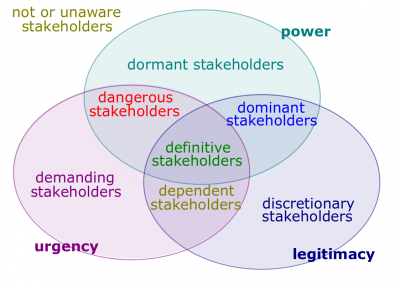Salience model
Salience model (hereinafter, the Model) is a stakeholder-analysis tool that classifies stakeholders depending on three attributes, which are (1) power, (2) legitimacy, and (3) urgency.
The term, salience, means the quality of being particularly noticeable, important or prominent, and so stakeholder salience means the importance you give to your stakeholders.
Stakeholder salience can be defined as the degree to which managers give priority to competing stakeholders' claims in their decision-making process.
History
The stakeholder salience model was proposed by Ronald K. Mitchell, Bradley R. Agle and Donna J. Wood in 1997. They proposed a Theory of Stakeholder Identification and Salience due to confusion over the definition of stakeholders and failure to reach a consensus over 'who and what really counts' in stakeholder management (Mitchell et al. 1997, p.853-854).
